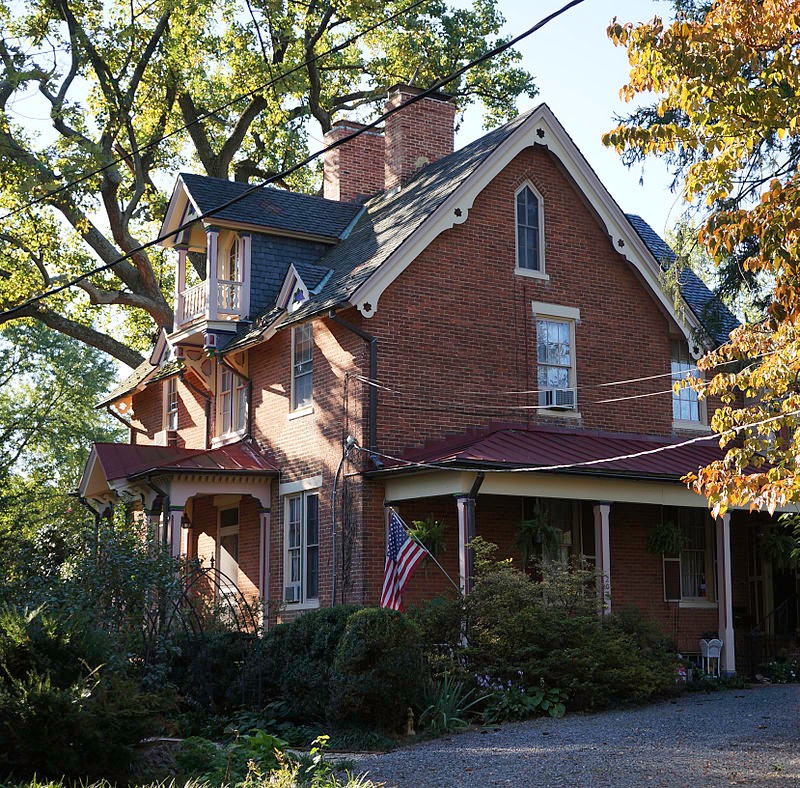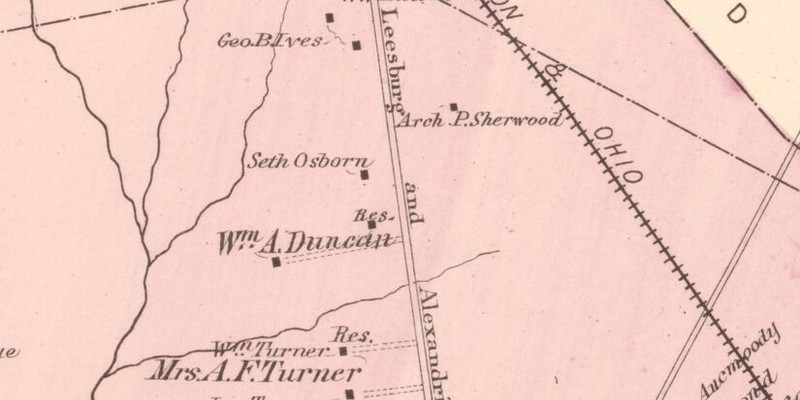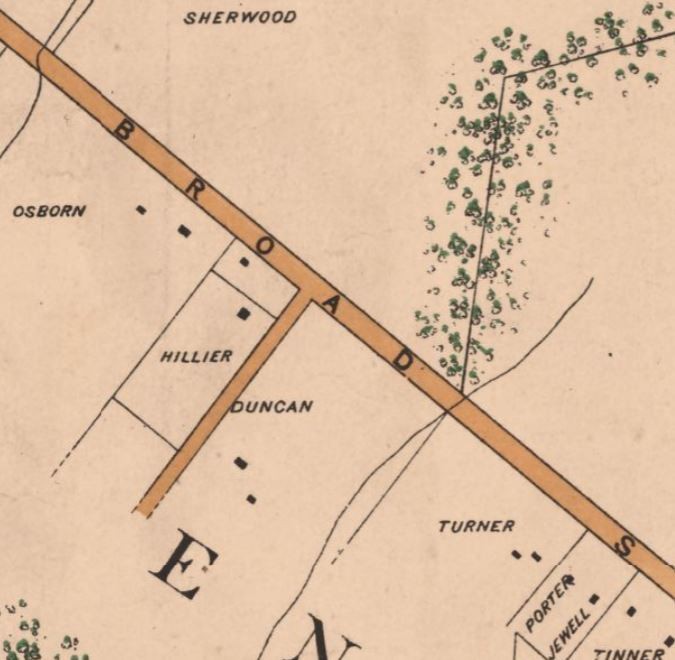Mount Hope
Introduction
Text-to-speech Audio
Images
Photo of Mount Hope by Bill Koplitz on September 24, 2012 (Wikimedia Commons)

William A. Duncan property, Mount Hope, on 1878 Hopkins Atlas map of Town of Falls Church, p. 63

Duncan property, Mount Hope, on 1890 Noetzel map of Falls Church

Backstory and Context
Text-to-speech Audio
Mount Hope is essentially two historic houses joined into one structure by infill of uncertain date. The earlier historic home, a simple frame 1-1/2 story dwelling, dates to 1829 or 1830 and is oriented toward the east. The later home is a fancier, brick house built for William A. Duncan in 1869 by local architect and postmaster A. E. Lounsbury for the impressive sum of $3,000. The 3-bay, 2-1/2 story brick dwelling faces the north toward Leesburg Turnpike. A brick 1-bay fill section of unknown date and varying heights joins the older to newer portions of the home.
The roof of the older section of the home has a gable roof with a shed roof western extension. The overhanging gable roof of the brick part of Mount Hope features a pair of corbel-topped chimneys. Although the height and massing of the home suggest a Gothic style, wooden detailing on the brick portion of Mount Hope contributes to the home's High Victorian architectural style. An incised design of a triangle superimposed on a trefoil is repeated on several places including over the entrance and as cutouts in the bargeboards. Another notable, unusual feature is a central bay on the north entrance elevation with a third-story balcony treated as a projecting dormer. Decorative interiors include molded plaster rondels on ceilings and marble mantels.
The property was offered for sale in November 1832 at public auction and was touted as having a new and comfortable frame dwelling house, two barns, other outbuildings, and farm machinery. Two African-American enslaved men were offered as part of the sale. The tract was formerly the property of Daniel F. Dulaney, Esquire, and Samuel Moxley was residing there at the time of the sale. The advertisement details suggest a farm of modest economic status. Historic research indicated that an earlier house on the tract burned down in 1829 and that Samuel Moxley built the frame, older portion of the existing house.
The new owner in 1832, Peter Ritter, was owed a debt by Moxley. Ritter may have continued to lease the property to Moxley but records are unclear. In 1840, Ritter sold the farm to Ruth Mills, who in turn sold to Amzie Coe in 1842. The 1842 deed mentioned that the property was in the actual possession of Mr. Coe, suggesting he may have been leasing the farm from Mills or managing the farm on-site. The Coe family held onto the land until 1869; they are likely the ones who came up with the name "Mount Hope." When Mr. Coe died in 1866, the farm had been reduced from 216 to 127 acres, which he left to his children and widow. By 1869, Amzie Coe's widow was residing in New York with one of her children when the farm was sold to William A. Duncan.
A lawsuit brought by the Duncan's architect for the brick home at Mount Hope, A. E. Lounsbury, mentioned that the Duncans lived in the frame house while he constructed the brick house. The Mount Hope house was assessed in 1875 at a whopping $6,000; this could have included barns and other outbuildings, though, or the fact that two separate houses stood on the tract after 1869. Examining historic maps suggests there may actually have been three houses in that era. An 1878 map (Hopkins Atlas) seems to show the Duncan residence ("Res.") as a second building, closer to Broad Street; the main house was at the end of a long access drive, passing south of the residence. The structure noted as the residence on the 1878 map was gone by the time an 1890 map of the town was prepared; the Mount Hope house and a nearby second, smaller structure to the southeast were present in 1890.
Duncan served as Mayor of Falls Church from 1881 to 1882 after the town formed from part of Fairfax County in 1875. When Duncan passed away, his 1900 will left the property to his late wife's cousin, Alma Berry, and a nephew, David Duncan Avril. The house was on a lot of 19.75 acres by this time. When Berry sold Mount Hope in 1919 to Lewis Gray - it is unclear if she had been living there - the lot was nearly 10 acres.
One interesting later owner was Joseph Allison, who purchased Mount Hope from the Gray's in 1924. The pharmacist manufactured a powder named Kleen Foot Balm to treat athlete's foot in the basement of the house, selling the product by mail order. Houses have been constructed surrounding the home in the twentieth century, including the front lawn, after Allison subdivided the land. The house and a half-acre lot remain from the former 216-acre farm, protected by an historic easement. Mount Hope was listed on the Virginia Landmarks and National Registers in 1984 and continues to be privately owned.
Sources
VA Dept. of Historic Resources. 110-0015 Mount Hope, Historic Registers, Falls Church (Indep. City). August 7th 2018. Accessed November 17th 2019. https://www.dhr.virginia.gov/historic-registers/110-0015/.
Wrenn, Tony P. . VA Landmarks Register staff. NRHP Nomination form for Mount Hope (110-0015).. Washington, DC. National Park Service, 1984.
https://commons.wikimedia.org/wiki/File:Mount_Hope_front.jpg
https://www.loc.gov/item/76354156/
https://www.loc.gov/item/92681730/
